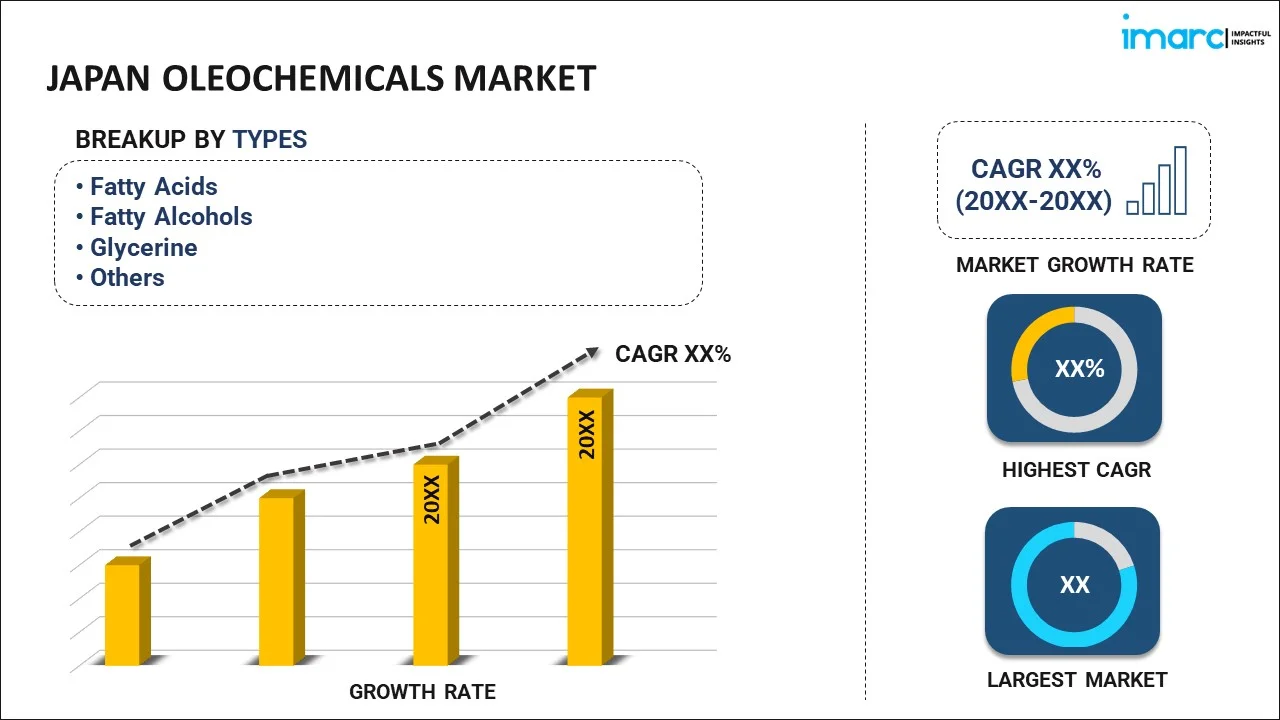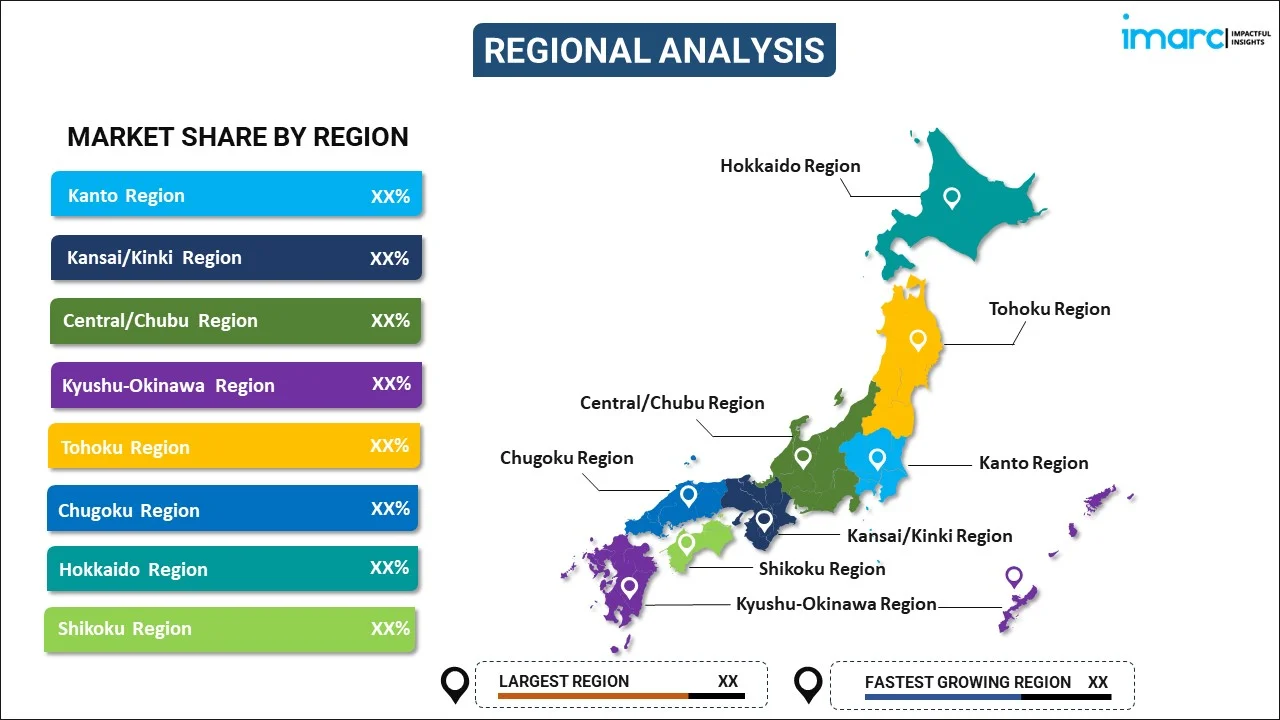
Japan Oleochemicals Market Report by Type (Fatty Acids, Fatty Alcohols, Glycerine, and Others), Form (Liquid, Solid), Application (Soaps and Detergents, Plastics, Paper, Lubricants, Rubber, Coatings and Resins, Personal Care Products, and Others), Feedstock (Palm, Soy, Rapeseed, Sunflower, Tallow, Palm Kernel, Coconut, and Others), and Region 2025-2033
Market Overview:
Japan oleochemicals market size reached USD 1,617.0 Million in 2024. Looking forward, IMARC Group expects the market to reach USD 2,859.0 Million by 2033, exhibiting a growth rate (CAGR) of 6.5% during 2025-2033. The market is experiencing growth primarily due to increased interest in skincare and cosmetic products derived from bio-based sources, mounting environmental apprehensions regarding sustainability, and supportive government programs promoting renewable chemicals to reduce carbon emissions.
|
Report Attribute
|
Key Statistics
|
|---|---|
|
Base Year
|
2024
|
|
Forecast Years
|
2025-2033
|
|
Historical Years
|
2019-2024
|
| Market Size in 2024 | USD 1,617.0 Million |
| Market Forecast in 2033 | USD 2,859.0 Million |
| Market Growth Rate 2025-2033 | 6.5% |
Oleochemicals comprise a category of chemicals derived from natural oils and fats, predominantly obtained from plants and animals. These chemicals are present in the form of fatty acids, glycerin, fatty alcohols, and esters, and they are acquired through various chemical processes like the hydrolysis or esterification of triglycerides found in oils and fats. Oleochemicals exhibit versatility and possess sustainable, environmentally friendly attributes that contribute to the reduction of environmental pollution. Consequently, they find extensive applications in industries such as cosmetics, pharmaceuticals, soap and detergent manufacturing, plastics, rubber, and paper production.
Japan Oleochemicals Market Trends:
In the context of the Japanese market, several factors are contributing to its growth. Firstly, there is an increased emphasis on sustainable development among the population, driven by concerns over rising pollution levels and the emission of harmful greenhouse gases. This heightened awareness has prompted numerous leading industry players to focus on utilizing renewable and cost-effective feedstocks for the production of oleochemicals. These efforts aim to create oleochemicals with reduced toxicity and environmental impact, as well as high biodegradability, thus bolstering market expansion. Furthermore, the market is benefiting from the surge in crude oil prices witnessed in various countries, leading to a notable uptick in the adoption of oleochemicals as alternatives. Additionally, the cosmetics industry's growing reliance on oleochemicals for producing safe consumer products, including lipsticks and eyeshadows, is fostering a positive market outlook. Moreover, the increased usage of oleochemicals in the formulation of surfactants, cleansing agents, emulsifiers, foam boosters, and degreasers is significantly supporting market growth. Furthermore, the rising adoption of oleochemicals in the production of food packaging materials and sanitizers for food contact surfaces is acting as a growth-inducing factor. Other factors, such as rapid industrialization and extensive research and development (R&D) activities conducted by key industry players in Japan, are anticipated to fuel the market growth over the forecasted period.
Japan Oleochemicals Market Segmentation:
IMARC Group provides an analysis of the key trends in each segment of the market, along with forecasts at the country level for 2025-2033. Our report has categorized the market based on type, form, application, and feedstock.
Type Insights:

- Fatty Acids
- Fatty Alcohols
- Glycerine
- Others
The report has provided a detailed breakup and analysis of the market based on the type. This includes fatty acids, fatty alcohols, glycerine, and others.
Form Insights:
- Liquid
- Solid
- Flakes
- Pellets
- Beads
- Others
A detailed breakup and analysis of the market based on the form have also been provided in the report. This includes liquid and solid (flakes, pellets, beads, and others).
Application Insights:
- Soaps and Detergents
- Plastics
- Paper
- Lubricants
- Rubber
- Coatings and Resins
- Personal Care Products
- Others
The report has provided a detailed breakup and analysis of the market based on the application. This includes soaps and detergents, plastics, paper, lubricants, rubber, coatings and resins, personal care products, and others.
Feedstock Insights:
- Palm
- Soy
- Rapeseed
- Sunflower
- Tallow
- Palm Kernel
- Coconut
- Others
A detailed breakup and analysis of the market based on the feedstock have also been provided in the report. This includes palm, soy, rapeseed, sunflower, tallow, palm kernel, coconut, and others.
Regional Insights:

- Kanto Region
- Kansai/Kinki Region
- Central/ Chubu Region
- Kyushu-Okinawa Region
- Tohoku Region
- Chugoku Region
- Hokkaido Region
- Shikoku Region
The report has also provided a comprehensive analysis of all the major regional markets, which include Kanto Region, Kansai/Kinki Region, Central/ Chubu Region, Kyushu-Okinawa Region, Tohoku Region, Chugoku Region, Hokkaido Region, and Shikoku Region.
Competitive Landscape:
The market research report has also provided a comprehensive analysis of the competitive landscape. Competitive analysis such as market structure, key player positioning, top winning strategies, competitive dashboard, and company evaluation quadrant has been covered in the report. Also, detailed profiles of all major companies have been provided.
Japan Oleochemicals Market Report Coverage:
| Report Features | Details |
|---|---|
| Base Year of the Analysis | 2024 |
| Historical Period | 2019-2024 |
| Forecast Period | 2025-2033 |
| Units | Million USD |
| Scope of the Report | Exploration of Historical and Forecast Trends, Industry Catalysts and Challenges, Segment-Wise Historical and Predictive Market Assessment:
|
| Types Covered | Fatty Acids, Fatty Alcohols, Glycerine, Others |
| Forms Covered |
|
| Applications Covered | Soaps and Detergents, Plastics, Paper, Lubricants, Rubber, Coatings and Resins, Personal Care Products, Others |
| Feedstocks Covered | Palm, Soy, Rapeseed, Sunflower, Tallow, Palm Kernel, Coconut, Others |
| Regions Covered | Kanto Region, Kansai/Kinki Region, Central/ Chubu Region, Kyushu-Okinawa Region, Tohoku Region, Chugoku Region, Hokkaido Region, Shikoku Region |
| Customization Scope | 10% Free Customization |
| Post-Sale Analyst Support | 10-12 Weeks |
| Delivery Format | PDF and Excel through Email (We can also provide the editable version of the report in PPT/Word format on special request) |
Key Questions Answered in This Report:
- How has the Japan oleochemicals market performed so far and how will it perform in the coming years?
- What has been the impact of COVID-19 on the Japan oleochemicals market?
- What is the breakup of the Japan oleochemicals market on the basis of type?
- What is the breakup of the Japan oleochemicals market on the basis of form?
- What is the breakup of the Japan oleochemicals market on the basis of application?
- What is the breakup of the Japan oleochemicals market on the basis of feedstock?
- What are the various stages in the value chain of the Japan oleochemicals market?
- What are the key driving factors and challenges in the Japan oleochemicals?
- What is the structure of the Japan oleochemicals market and who are the key players?
- What is the degree of competition in the Japan oleochemicals market?
Key Benefits for Stakeholders:
- IMARC’s industry report offers a comprehensive quantitative analysis of various market segments, historical and current market trends, market forecasts, and dynamics of the Japan oleochemicals market from 2019-2033.
- The research report provides the latest information on the market drivers, challenges, and opportunities in the Japan oleochemicals market.
- Porter's five forces analysis assist stakeholders in assessing the impact of new entrants, competitive rivalry, supplier power, buyer power, and the threat of substitution. It helps stakeholders to analyze the level of competition within the Japan oleochemicals industry and its attractiveness.
- Competitive landscape allows stakeholders to understand their competitive environment and provides an insight into the current positions of key players in the market.
Need more help?
- Speak to our experienced analysts for insights on the current market scenarios.
- Include additional segments and countries to customize the report as per your requirement.
- Gain an unparalleled competitive advantage in your domain by understanding how to utilize the report and positively impacting your operations and revenue.
- For further assistance, please connect with our analysts.
 Inquire Before Buying
Inquire Before Buying
 Speak to an Analyst
Speak to an Analyst
 Request Brochure
Request Brochure
 Request Customization
Request Customization




.webp)




.webp)












